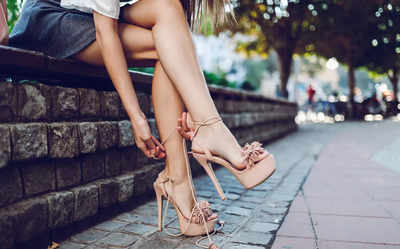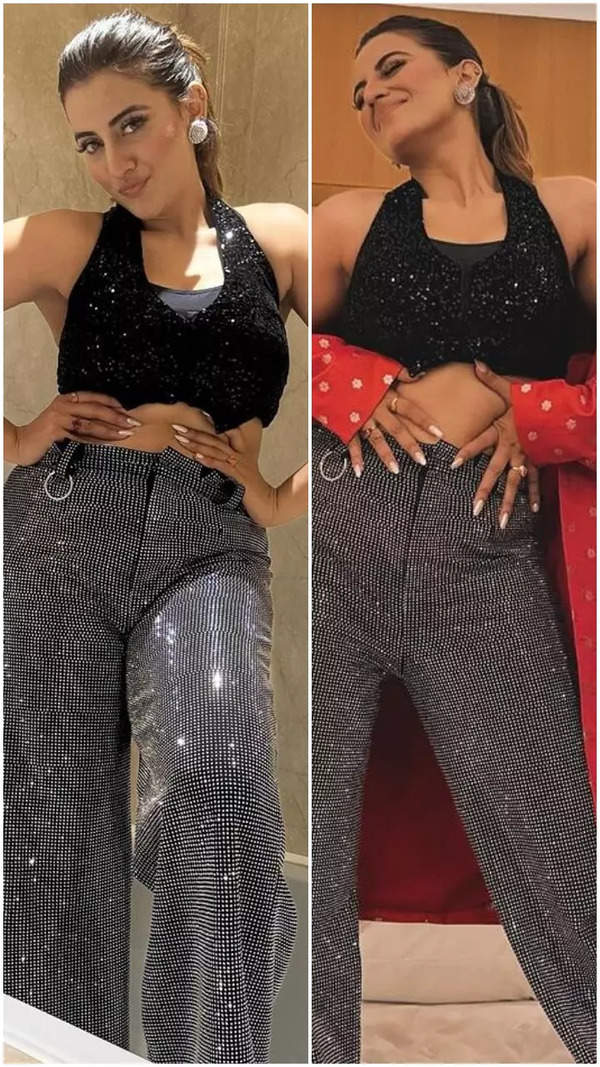Trending
This story is from August 21, 2022
In love with heels? Here are some tips for you
Heeled footwear has been in use by women for centuries and has now become an integral part of the wardrobe not only in the west but also in India. Recent research suggests that up to one third of women suffer from permanent problems as a result of their prolonged wearing of heels.

Heeled footwear has been in use by women for centuries and has now become an integral part of the wardrobe not only in the west but also in India. Recent research suggests that up to one third of women suffer from permanent problems as a result of their prolonged wearing of heels. One in 10 women wear it at least for 3 days a week, and a recent survey found that one-third of them had permanent problems.High heels change their wearer’s walking pattern. The average person who regularly sports heels takes shorter and more forceful strides when walking than those who regularly wear flat shoes. Dr. Manan Vora, Orthopaedic Surgeon, Sports Medicine Expert & Content Creator shares insights on how to wear heels, comfortably.
The problem, of course, is that they aren’t good for you. They likely leave your feet aching, regardless of how comfortable they are. After a few hours, you probably have an ache in your lower back, your knees might hurt, and the balls of your feet may hurt - a pain called metatarsalgia - due to the excessive downward force exerted on them. When wearing heels, the body must adjust and shift its overall weight and centre of gravity to compensate for the heel of the shoe. The higher the heel, the higher the risk of lower back, hip, and knee issues.
With habitual wearing of heels two inches or higher, the Achilles tendon and calf muscles can face changes in shape. As the shoe heel pushes up the human heel, the Achilles tendon and calf muscles are facing increased pressure. The tendon may shorten, and the muscles can stiffen and reshape. This can occur in individuals who frequently wear heels, and can create pain in the body’s lower extremities.
After years of high heel wear and body readjustment due to the shoes, you may experience discomfort when wearing flat shoes or walking barefoot. The body will have adapted to the shape of the heels, causing irritation when other types of shoes are worn. The higher the heel, the worse the problem. A one-inch heel exerts about 22% more pressure on the ball of your foot than a flat shoe. With a three-inch heel, there’s more than 75% more pressure on your forefoot.
If you are feeling the consequences of constantly wearing heels, there are steps you can take to help combat the aching and discomfort. These suggestions can help decrease the pain you are feeling from wearing high heel shoes.
While completely stopping to wear heels isn’t feasible, here are a few tips that you can keep in mind while purchasing and wearing your favourite heels.
The problem, of course, is that they aren’t good for you. They likely leave your feet aching, regardless of how comfortable they are. After a few hours, you probably have an ache in your lower back, your knees might hurt, and the balls of your feet may hurt - a pain called metatarsalgia - due to the excessive downward force exerted on them. When wearing heels, the body must adjust and shift its overall weight and centre of gravity to compensate for the heel of the shoe. The higher the heel, the higher the risk of lower back, hip, and knee issues.
With habitual wearing of heels two inches or higher, the Achilles tendon and calf muscles can face changes in shape. As the shoe heel pushes up the human heel, the Achilles tendon and calf muscles are facing increased pressure. The tendon may shorten, and the muscles can stiffen and reshape. This can occur in individuals who frequently wear heels, and can create pain in the body’s lower extremities.
After years of high heel wear and body readjustment due to the shoes, you may experience discomfort when wearing flat shoes or walking barefoot. The body will have adapted to the shape of the heels, causing irritation when other types of shoes are worn. The higher the heel, the worse the problem. A one-inch heel exerts about 22% more pressure on the ball of your foot than a flat shoe. With a three-inch heel, there’s more than 75% more pressure on your forefoot.
Wearing high heels once in a great while probably won’t pose any immediate dangers to your health, however, wearing them daily or even weekly very well may. High-heeled shoes can cause a plethora of foot problems while impairing stability and increasing the risk of injury. Leg, back, and foot pain are among some of the more common complaints. Long-term use can even cause structural changes in the foot itself, leading to bunions, hammertoe, neuroma, equinus, and other conditions that may require surgical correction. In addition to injury, high heels place excessive stress on the back and lower extremities that can profoundly affect posture, gait, and balance.
If you are feeling the consequences of constantly wearing heels, there are steps you can take to help combat the aching and discomfort. These suggestions can help decrease the pain you are feeling from wearing high heel shoes.
- Change your shoe choice – Go for flat shoes, or shoes that provide more support and cushion.
- Switch up your exercise routine – Reduce frequent stress on your knees, hips, and lower back while exercising. Rowing, swimming, and the elliptical are low-impact types of exercises that are easier on your joints.
- Minimize the amount of days you wear heels – Try adding flats or wedges to your shoe selection.
- Go for a shorter heel – Heels two inches or less put less pressure on joints.
- Stretch your calves before and after wearing heels – Allow yourself time for lunges or other calf-stretching methods.
- Place cushions in your shoes and heels – Make your shoe choices more comfortable for your feet.
- While purchasing heels, make sure you buy the right size that fits you well. If you buy a bigger size, you can fall. If you buy a smaller size, it can be tight thereby causing pain.
- Some of us have narrow feet, some have wide, some have smaller toes, while some might have long toes. There are so many variations. If you have wide feet, do not to wear closed tapered shoes, wear wide front closed ones or open toe ones. Even those with smaller toes should opt for closed wide front shoes. The pointed front shoes will pinch your toes and make it very uncomfortable. Heels that cramp your toes will cause pain when walking and increase the possibility of getting bunions, corns and developing hammertoes and even arthritis later in life.
- Wearing heels puts more pressure on your feet, especially the balls of the feet. Before purchasing that coveted pair, check that they have proper padding and cushioning in the area that supports the balls of feet. High heels with excellent cushioning and padding provide great support and comfort to your feet.
- When choosing high-heels, check where the heel is placed. The heel should ideally be placed under your own heel. Remember, thicker the heel, the greater the support it provides for your body. Look for platforms that will distribute your weight across the entire foot evenly instead of concentrating it at the ball of the foot or the heel. So, go for wider, thicker heels if you want to decrease the risk of sprained ankles.
- High heels that are 3 cm to 9 cm high are the most comfortable to walk in. Heels more than that height put more pressure on your lower back, knees, ankles and do not give any support for balancing.
- Give your feet a break. When wearing high heels, the best advice you can take to prevent pain is just to sit down whenever possible! This will give your feet a break and will stop any pain or discomfort from building, keeping your feet fresh.
- Don't wear high heels too often. High heels look fabulous, but save them for special occasions only.
End of Article
FOLLOW US ON SOCIAL MEDIA









